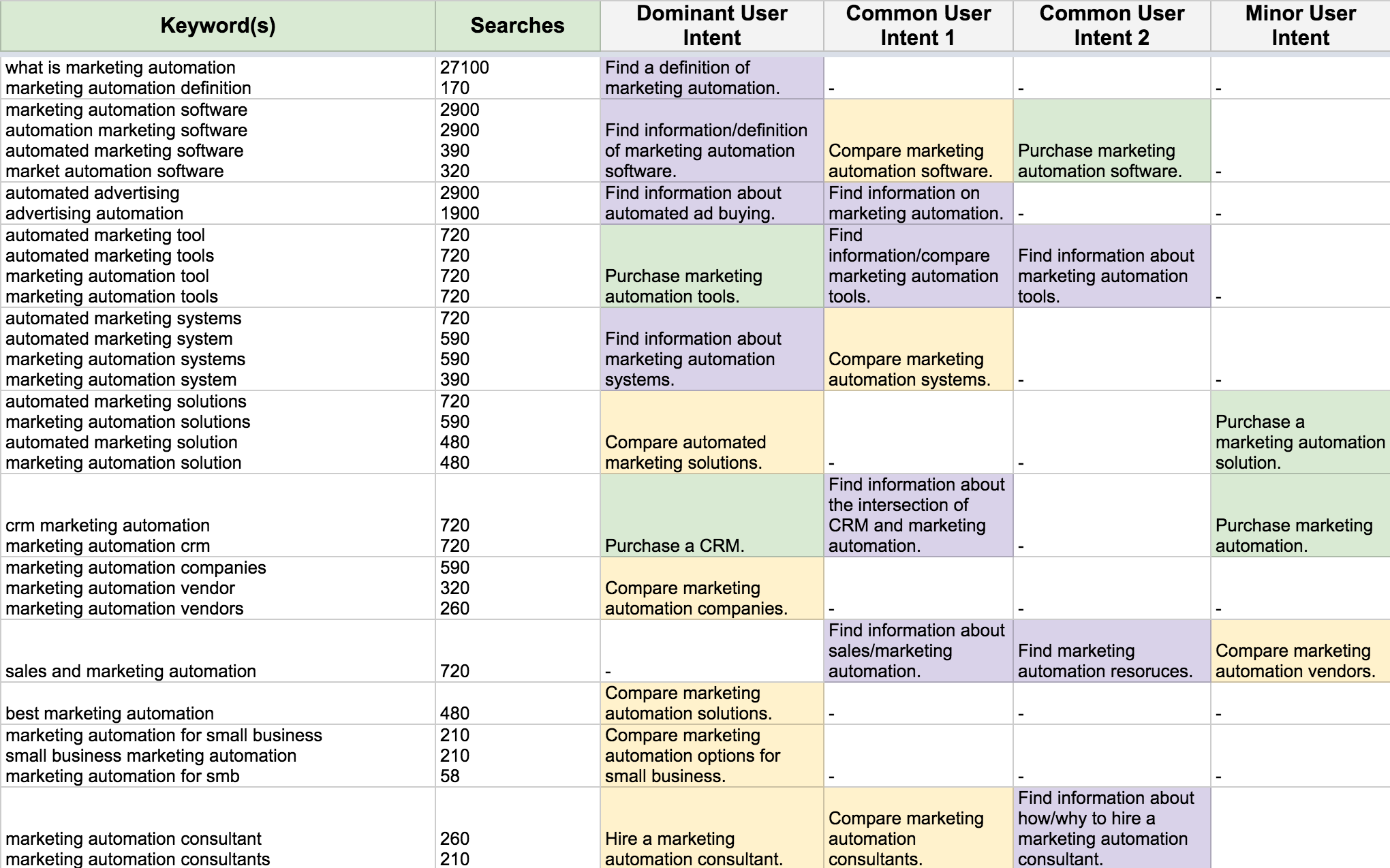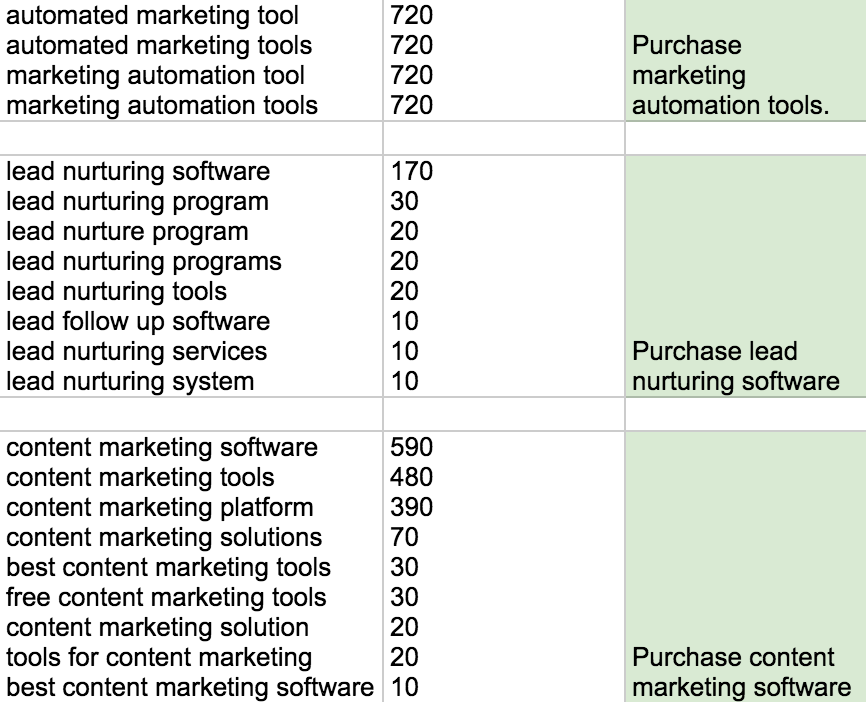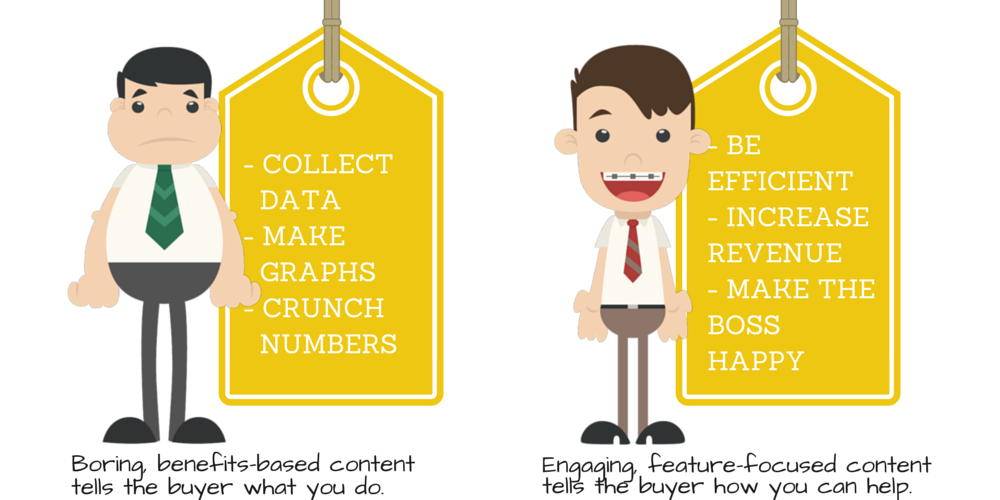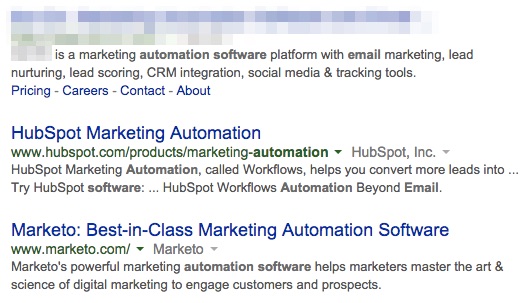8 SEO Best Practices for SaaS Product Pages
Can I be honest on the internet? Get something off my chest? Most of the SaaS product pages I’ve seen are all wrong (and it seems to be contributing to a serious bit of SEO slander).
Let me explain. And then let me help you fix it. (To be clear, and to prevent disappointing anybody, I’m not really addressing ecommerce product pages here. I’m talking about product a.k.a. sales pages for SaaS companies, although these concepts will apply to any page trying to make a sale.)
Most of Your Audience Is Not Ready to Buy
If you’re a B2B marketer, chances are good that only 10% of the organic search you are trying to rank for (across all your keywords) are close to considering a purchase. How do I know? We do a lot of user-intent analysis.
An effective use of keywords starts when we look at the buyer’s search experience—reading between the proverbial lines of a search query to discover the motive, and predict the user’s next move. Each seemingly static keyword can actually represent many user intents, because users type in search keywords for very specific reasons. Since each keyword represents multiple intents, we need to think about our content in terms of the user’s end game, not just the keyword.

Example user intent analysis of ‘marketing automation’ keywords.
In nearly every B2B campaign our team has worked on, we have found that about 90% of search volume has an “intent” which is not purchase related. In other words, 90% of the searchers behind keywords are not ready to buy, and are therefore not going to call you today for a product demo.
At best, they will download a gated resource, or follow your blog or social channels. (But that’s OK! That 90% is full of great opportunities. That’s what gated resource content is for. Collect emails with top-of-funnel content, so you can then nurture them into sales-ready leads.) The other 10% is high-value traffic, but your sales pages need to be performing at 100% to convert as much of it as possible.
Why They Say “SEO Traffic Doesn’t Convert” – The 90%
Too many marketers think that SEO doesn’t convert because they don’t take the time to study user intent, and they don’t always focus SEO efforts on the right pages. When we consider content in light of keyword + user intent combos—and with the understanding that only about 10% of organic B2B traffic is ready to buy—we can fill in the gap between SEO and conversions. That’s why:
- Even your very best optimized product pages will still probably only capture 10% of your potential organic search traffic.
- SEO should aim to earn and then convert this sales-ready traffic.
- If you’re not also building a resource-driven SEO strategy to attract this massive traffic opportunity, you’re missing out.
It’s not that SEO doesn’t convert—it’s that most SEO isn’t being properly applied. So how do you properly apply SEO in order to convert that precious 10%? Glad you asked …
1. Market Your Product First, SEO Second
I’ve come across many marketers who gave up on SEO because they tried too hard, things got weird, and they figured SEO never works. You can have too much of a good thing—even SEO. Product pages are very important pages on your website (i.e. lots of internal links), so you want to make the most of their SEO value. But never cross the line into “forcing it.”
- If the only relevant keywords for a particular product page are low-traffic (or no traffic), that’s okay. Using low traffic keyword concepts is much better than stuffing the content full of irrelevant keywords.
- If you find some keywords that don’t have a product page, consider adding one—but not at the cost of confusing or overwhelming your user.
When optimizing the product side of your website, the user experience (read: conversions!) still matter most. That means:
- Always design your product section with the primary goal of making a sale.
- A careful study of keywords and user intent can help refine and expand your understanding of your market’s needs and desires.
- Over-optimized sales pages could even deter conversions.
Your product department may be a valuable resource, here. They’re intimately familiar with your products and services (and they’re probably going to want to have a say in the product pages anyway). Glean all the insight you can, and then work on your SEO best-practices.
2. Align User Intent (and Keywords) with Appropriate Product Pages
A proper understanding of the user intent behind your keywords gives you the foundation you need to align the right product pages with the right keywords. If you don’t have your keywords figured out, there are a lot of great resources out there. If you don’t yet have a solid understanding of your keywords’ user intent, there are not as many resources that I can recommend just yet. (I did write this piece on Search Engine Land, and we have several more detailed pieces in the works.)
Once you know your keyword + user intent combos, you can start to link your product pages appropriately . Below are a couple examples.

At this point in the research process it should become fairly clear which product pages should be optimized for which keyword + user intent groups.
3. Focus on Benefits, Not Features
“Features” may be main link in your site’s navigation, but it better not be all you talk about! Users (especially your future buyers) don’t care about features. They don’t care about how your product works, the tools it offers, the different sections of your UI interface. Buyers want to know how your product will benefit them. Every product page on your website needs to talk specifically to the needs of your audience, and how your product specifically meets those needs.

This translates directly to SEO: users are not searching for your product’s features (even when they type feature-related queries into the search bar). They’re really searching for solutions to their needs. Too many sales pages focus on Product X, and how it includes Tool A, B, and C. Don’t be just another tool.
How will your solution revolutionize business, solve problems, and ease pain? Don’t make the buyer connect the dots between your product and the answer they’re looking for. Not sure where to start? Talk to your sales department. They relate the product to prospects and clients every day, and are familiar with the questions asked and the solutions favored.
4. Craft Appealing Search Result Snippets
One convenient aspect of SEO is that the competitive landscape is easy to view – just do a search! (I recommend using depersonalized search to get the cleanest results possible.) Once you search for a keyword, you’ll see all of your competitors. Your goal should be to craft a search snippet that stands out and promises so much value, every searcher is drawn to click on it.

The first result for “email automation software” is all about features—boring. HubSpot does better, but it seems there’s no designated meta because the sentences are cut off. Marketo’s SERP tells marketers what their software does, but also how it will help them do their jobs better.
How do you draft a compelling page title and meta description? We use what we call SERP Engagement Principles:
- The most appropriate keyword—Users tend to skip results that do not include their keyword, and keyword use is important for ranking.
- A value proposition—Give users a reason to click on your search result.
- A call to action—A verb like, “learn,” “see,” “discover,” etc.
-
A unique element—Most search results are stuffed with similar pages, so yours needs to stand out.
- Include your brand name—Google and users tend to prefer seeing your brand name in page titles.
Of course it can be very challenging to squeeze all four SERP Engagement Principles into Google’s length guidelines, which are even smaller than before. The more the merrier, the better, but be sure to apply at least 2 of them on every page.
5. Include Social Buttons, Maybe?
Sales pages don’t go viral, and that’s okay. Many brands don’t add social buttons to product pages because they don’t want visitors to see low share counts. Without those social buttons, however, pages are even less likely to get shared, if ever.

Rather than miss potential share opportunities, I always recommend that product pages do include social buttons. If the share counts are in fact low or non-existent, simply turn the share counts off.
6. Include One Relevant, Appealing Call-to-Action on Every Page
If your business offers freemium access or a free trial, connect your live demo offer with the specific benefit your buyer is investigating. “Experience X now with a 30-day trial.” If you don’t have a trial to offer, have additional, relevant content ready for the user who wants more information. Let them watch a demo or download a buyer’s guide. Users are bombarded with CTAs all day long. If you want your site visitors to actually take action, give them a real reason to do so. A generic call-to-action is almost as bad as no call-to-action at all.
7. Practice Smart SEO
A “complete” SEO checklist would be endless. I’m constantly encouraging clients (and our own consulting teams) to focus on what will drive the most results in the shortest time period. The principles and processes I’ve already described above are some of the most valuable SEO practices a SaaS company can use to optimize their product pages, but there are a few more of the basics:
- Use keywords wisely—Discuss the keyword(s), but don’t stuff the page full of the same one or two words. Use it in the title, near the top of the content, along with appropriate synonyms and variation, and naturally in headers and content on the rest of the page.
- Discuss related keywords—Search engines are looking for content that demonstrates genuine authority, and that means using related keywords in headers and supporting sections.
- Images and video—Users and search engines both love images and video. Video can be especially helpful in keeping users on the page longer.
- URL—Make sure your page’s URL is as short and descriptive as possible, including the keyword whenever possible and appropriate. Cut out unnecessary folders, and use plain, user-friendly language.
- Be mobile friendly—Mobile has become an SEO-must.
- Technical—Use clean/error-free code, make sure your site loads fast, etc.
8. Practice Modern SEO
Google’s AI-driven algorithm is much smarter than we realize. Algorithm updates are probably happening each and every day, without our knowledge, and sites trying to fake it simply don’t make it. That’s why we need to always prioritize user experience over keywords and code. Technical SEO considerations are foundational to ranking well, but they do not deliver competitive value.
Delighted users, on the other hand, give Google all of those earned metrics that have the greatest impact on driving high rankings: high click-through rates, low bounce rates, increase time-on-site, shares, and even links. There is no universal, “How to Delight Users” handbook, because your target audience is different from another niche’s target audience, but you can start with some basic best practices:
- Use engaging images and video
- Answer the buyer’s questions quickly and efficiently
- Always provide clear next-steps
How to Optimize Product Pages Today
With only 1 in 10 searches specifically targeting products or services for purchase, product pages represent only a small portion of potential SEO traffic – but that traffic is perhaps the most valuable. AS SEO continues to evolve, and grow, marketers have new opportunities to earn the right SEO traffic, and convert that traffic to new business.
What's Next?
Profound Strategy is on a mission to help growth-minded marketers turn SEO back into a source of predictable, reliable, scalable business results.
Start winning in organic search and turn SEO into your most efficient marketing channel. Subscribe to updates and join the 6,000+ marketing executives and founders that are changing the way they do SEO:
And dig deeper with some of our best content, such as The CMO’s Guide to Modern SEO, Technical SEO: A Decision Maker’s Guide, and A Modern Framework for SEO Work that Matters.




